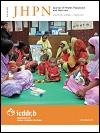Storing Drinking-water in Copper pots Kills Contaminating Diarrhoeagenic Bacteria
DOI:
https://doi.org/10.3329/jhpn.v30i1.11271Keywords:
Bacteria, Copper, Diarrhoea, Drinking-water, Vibrio cholerae, IndiaAbstract
Microbially-unsafe water is still a major concern in most developing countries. Although many water-purification methods exist, these are expensive and beyond the reach of many people, especially in rural areas. Ayurveda recommends the use of copper for storing drinking-water. Therefore, the objective of this study was to evaluate the effect of copper pot on microbially-contaminated drinking-water. The antibacterial effect of copper pot against important diarrhoeagenic bacteria, including Vibrio cholerae O1, Shigella flexneri 2a, enterotoxigenic Escherichia coli, enteropathogenic E. coli, Salmonella enterica Typhi, and Salmonella Paratyphi is reported. When drinking-water (pH 7.83±0.4; source: ground) was contaminated with 500 CFU/mL of the above bacteria and stored in copper pots for 16 hours at room temperature, no bacteria could be recovered on the culture medium. Recovery failed even after resuscitation in enrichment broth, followed by plating on selective media, indicating loss of culturability. This is the first report on the effect of copper on S. flexneri 2a, enteropathogenic E. coli, and Salmonella Paratyphi. After 16 hours, there was a slight increase in the pH of water from 7.83 to 7.93 in the copper pots while the other physicochemical parameters remained unchanged. Copper content (177±16 ppb) in water stored in copper pots was well within the permissible limits of the World Health Organization. Copper holds promise as a point-of-use solution for microbial purification of drinking-water, especially in developing countries.
DOI: http://dx.doi.org/10.3329/jhpn.v30i1.11271
J HEALTH POPUL NUTR 2012 Mar;30(1):17-21
Downloads
462
261

